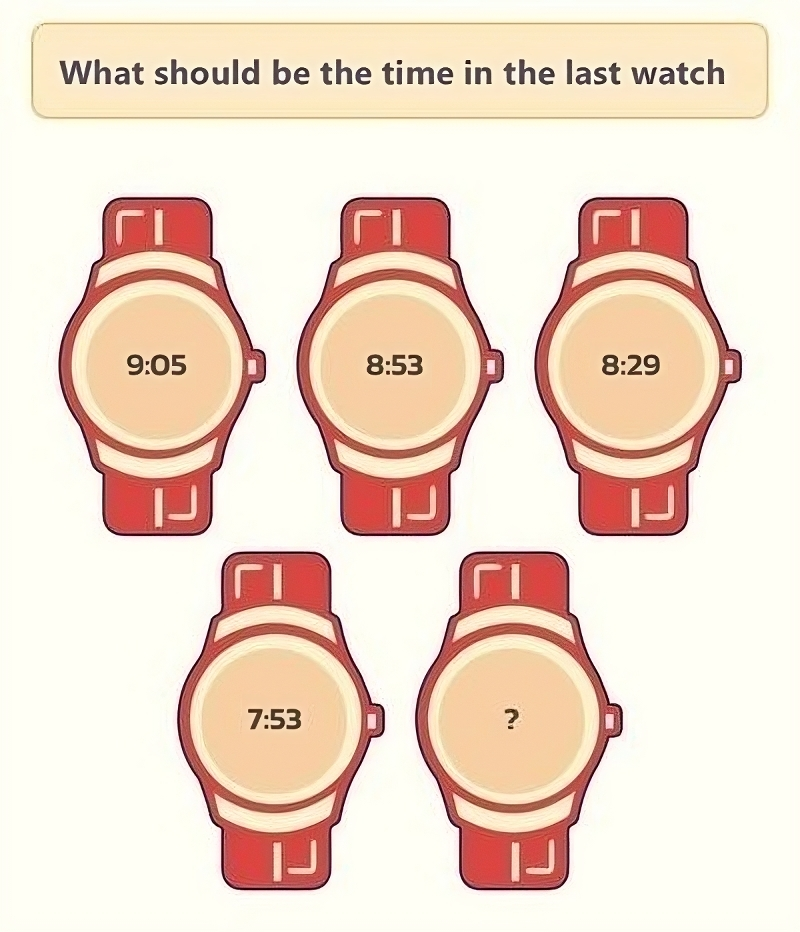When it comes to brainteasers, even the simplest-looking puzzles can be unexpectedly difficult. The watch puzzle we’re about to break down is a great example. At first glance, it seems like a straightforward sequence involving different times displayed on a series of watches. But solving this puzzle requires you to recognize a changing pattern rather than a simple arithmetic progression. Are you ready to crack it?
Let’s dive into the details, understand the common mistakes, and reveal the solution step-by-step.
Understanding the Watch Puzzle: What’s the Goal?

The watch puzzle involves a series of watches showing different times, with the challenge being to determine the time on the fifth and final watch. Here’s how the times are displayed:
- First Watch: 9:05
- Second Watch: 8:53
- Third Watch: 8:29
- Fourth Watch: 7:53
- Fifth Watch: ?
At first glance, you might assume the time changes at regular intervals. However, the trick lies in observing that the interval itself changes progressively. Let’s explore why this puzzle is harder than it looks and how to solve it.
Why This Puzzle Is Trickier Than It Seems
The watch puzzle can catch you off guard for several reasons:
- Inconsistent Time Differences: The time decreases between watches, but the amount of decrease changes with each step.
- Increasing Interval Gaps: The time difference doesn’t stay constant; it increases in a specific pattern.
- Rushing to Conclusions: Solvers often make the mistake of assuming a regular sequence and miss the deeper logic.
So, how can you identify the correct pattern? Let’s break it down step-by-step.
Step-by-Step Solution to the Watch Puzzle
Step 1: Analyze the Time Differences Between Watches
The first step is to calculate the time difference between each pair of watches:
- First to Second Watch: 9:05 to 8:53 = 12-minute decrease
- Second to Third Watch: 8:53 to 8:29 = 24-minute decrease
- Third to Fourth Watch: 8:29 to 7:53 = 36-minute decrease
As you can see, the time difference is not consistent, but it does follow a pattern.
Step 2: Recognize the Increasing Time Interval Pattern
Upon closer inspection, you’ll notice that the time decreases follow a specific progression:
- First decrease: 12 minutes
- Second decrease: 24 minutes (12 + 12)
- Third decrease: 36 minutes (12 + 12 + 12)
The time decreases by an additional 12 minutes with each step. This means that the difference from the fourth watch to the fifth watch should be 48 minutes (12 + 12 + 12 + 12).
Step 3: Calculate the Time on the Fifth Watch
Now, apply the identified pattern to find the correct time for the fifth watch:
- Fourth Watch: 7:53
- Subtract 48 minutes from 7:53:
To perform the subtraction:
- 7:53 minus 48 minutes = 7:05
So, the correct time displayed on the fifth watch is 7:05.
Why the Correct Answer Is 7:05

The solution follows the logic of increasing time intervals, with each step adding an extra 12 minutes to the decrease. By carefully observing this pattern, you can accurately determine that the time on the last watch is 7:05.
Common Mistakes Solvers Make
- Assuming a Consistent Difference: One of the most common errors is assuming that the difference between each watch is the same. People often look for a steady decrease in time, such as subtracting 10 or 15 minutes at each step.
- Ignoring the Pattern Change: Some solvers notice that the time is decreasing but fail to recognize that the rate of decrease is increasing consistently.
- Rushing to Answer: Often, people think they’ve found the solution after spotting an initial pattern but forget to check whether it holds for all the watches. This can lead to incorrect conclusions.
What Makes This Puzzle Fun and Engaging?
The appeal of this puzzle lies in its ability to test not just basic arithmetic skills but also logical reasoning. It encourages you to look beyond surface-level patterns and dig deeper to uncover a hidden progression. The increasing intervals add a layer of complexity that makes it both challenging and rewarding to solve.
Puzzles like this one highlight the importance of patience, attention to detail, and a willingness to rethink initial assumptions. It’s not just about finding the answer—it’s about understanding how the answer is reached.
Why Puzzles Are Great for Developing Analytical Skills
Puzzles, especially those with changing patterns like this one, offer a mental workout that sharpens problem-solving skills. They require critical thinking, pattern recognition, and the ability to adapt your approach based on new observations. Engaging with such puzzles can help you develop a more flexible mindset, which is beneficial not only in puzzle-solving but also in real-life problem-solving scenarios.
Challenge Your Friends with the Watch Puzzle
Did you manage to solve it on your own? If so, well done! If not, don’t worry—this puzzle is meant to be tricky, and it’s a great opportunity to learn and improve your logical thinking skills. Share it with friends and family, and see if they can crack the code. You might be surprised by the different approaches people take to arrive at the solution.
Conclusion: Mastering the Watch Puzzle
The watch puzzle is a perfect example of how even a seemingly simple problem can turn into a brain-bending challenge. By paying close attention to the pattern of change, you can uncover the correct answer step-by-step. Remember, puzzles like this are more than just fun—they’re a chance to develop patience, analytical thinking, and problem-solving skills.
Keep challenging yourself with similar puzzles to enhance your logical abilities and enjoy the thrill of cracking the code. The next time you encounter a brainteaser, approach it with curiosity, careful observation, and a willingness to explore deeper patterns. You might just surprise yourself with what you can solve


